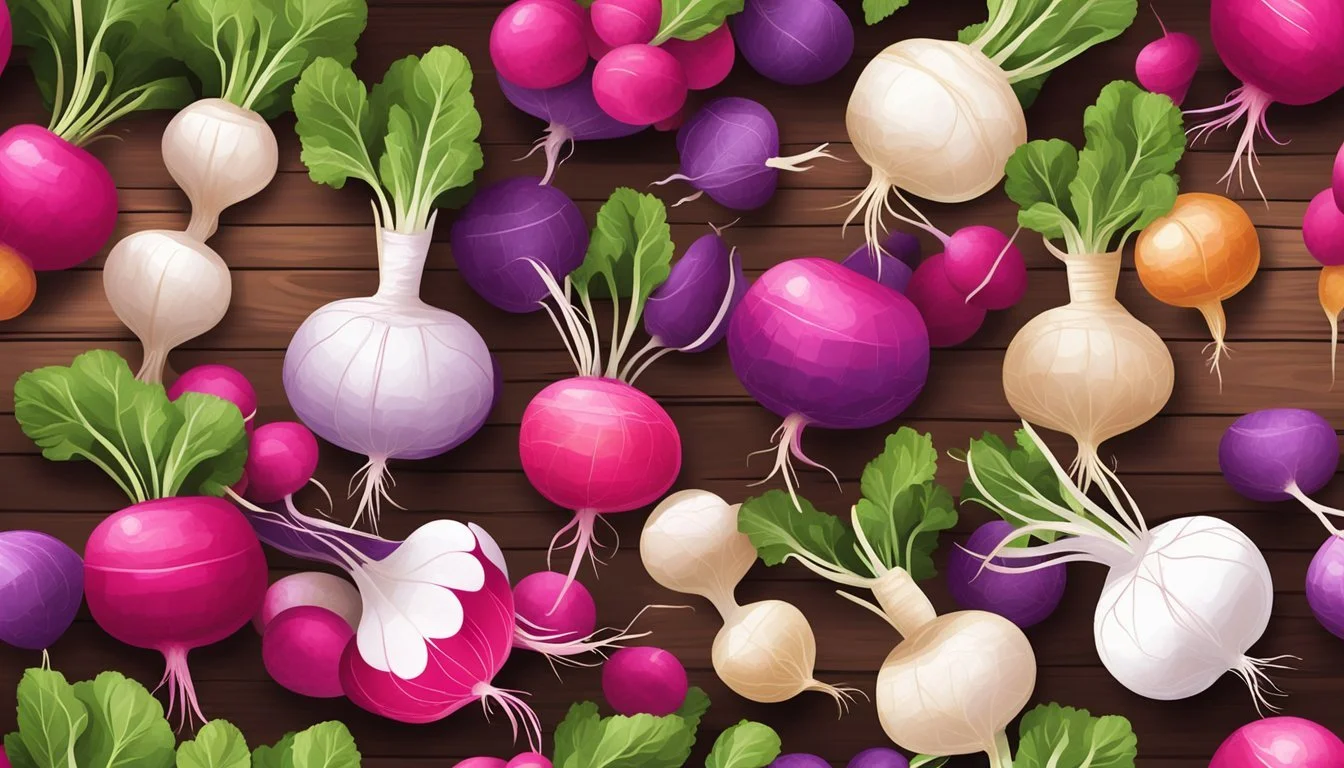Easter Egg Radish Substitutes
Best Alternatives for Your Recipes
Looking for substitutes for the vibrant and crunchy Easter Egg radish? You’ve come to the right place. Whether you're out of these colorful bulbs or simply looking for a different twist in your salad, there are several radish varieties that can stand in for Easter Egg radishes without missing a beat. French Breakfast radishes, with their mild flavor and crisp texture, make an excellent substitute.
Other great options include Cherry Belle radishes, known for their bright red color and slightly peppery taste. They mimic the tenderness and versatility of Easter Egg radishes quite well. Additionally, Watermelon radishes, with their striking pink interiors and spicy-sweet flavor, provide both visual appeal and a flavor punch, making them another top choice for your culinary needs.
These radish alternatives will not only provide the crunch and color you’re accustomed to with Easter Egg radishes but also add their unique flavors, enhancing your dishes in delightful ways.
Understanding Easter Egg Radishes
Easter Egg Radishes are known for their vibrant colors and mild flavor. These springtime vegetables are beloved for their visual appeal and versatility in culinary applications.
Origins and Characteristics
Easter Egg Radishes originate from hybridization processes that create their unique polyploid nature. This process results in the radishes having more than two sets of chromosomes, contributing to their varied and vivid colors. Typically, these radishes come in shades of red, white, purple, and pink, making them an attractive addition to any dish. Their shapes are often round, resembling Easter eggs, hence the name. They are usually planted in early spring and grow quickly, maturing in about 30 days.
Culinary Uses
Easter Egg Radishes offer a mild spice and crisp texture, making them versatile in the kitchen. They can be used raw in salads, providing a colorful and crunchy element. Their mild flavor also makes them suitable for pickling, where their vibrant colors are beautifully preserved. Cooked applications such as roasting or sautéing bring out a slight sweetness while maintaining their colorful appeal. These radishes can also serve as eye-catching garnishes to enhance the visual appeal of a dish.
Nutritional Profile
Easter Egg Radishes are not only visually appealing but also nutritious. They are low in calories and high in fiber. These radishes provide essential vitamins and minerals. They are particularly rich in vitamin C, which supports the immune system. Additionally, they contain antioxidants that help reduce oxidative stress in the body. Including Easter Egg Radishes in your diet can contribute to overall health, making them a valuable addition to any meal plan.
Growing Easter Egg Radishes
Easter Egg Radishes are a colorful variety that can be grown successfully with the right approach to planting, soil management, and harvesting.
Planting and Care
Sow Easter Egg Radish seeds 1/2 inch deep and 1 inch apart. This spacing allows each radish enough room to grow without overcrowding. Choose a spot in your garden that receives at least 6-8 hours of direct sunlight daily. These radishes thrive in full sun.
When planting, ensure that the soil remains moist but not waterlogged. Regular watering is essential, particularly during dry periods. If grown in containers, ensure the pot is at least 6 inches deep and has good drainage. Radishes germinate quickly, generally within a few days, and can be harvested in about 30 days.
Soil and Water Requirements
Easter Egg Radishes prefer well-drained, loose soil with a pH between 5.5 and 6.8. Before sowing, enrich the soil with compost or a balanced fertilizer to enhance nutrient availability. Avoid compacted or heavy clay soils, which can hinder growth.
Maintain consistent moisture in the soil. Water thoroughly but allow the soil to dry slightly between waterings to prevent root rot. In particularly hot climates, some partial shade during peak sunlight hours can help prevent the soil from drying out too quickly. Proper water management ensures healthy growth and prevents the radishes from becoming too spicy or woody.
Harvesting Practices
Easter Egg Radishes are generally ready for harvest when they reach a diameter of 1-2 inches. Check for size regularly, as leaving them to grow too large can result in a hotter taste. To harvest, gently grasp the top of the radish and pull it upwards.
After harvesting, trim the greens off, leaving about an inch of stem. This helps preserve the freshness of the radish. Harvesting at the right time and size ensures the best flavor and texture. Enjoy them fresh or store them in the refrigerator to maintain their crispness.
Substitute Options for Easter Egg Radishes
Easter Egg radishes can be swapped with several other radish varieties and unique vegetables offering a range of similar tastes, different textures, and specific cooking considerations.
Similar Tasting Varieties
Several radish varieties can substitute Easter Egg radishes due to their similar tastes and textures. Cherry Belle radishes have a mild flavor and crisp texture, making them ideal replacements in raw dishes like salads.
French Breakfast radishes provide a slightly milder flavor compared to Easter Egg radishes but still deliver a satisfying crunch.
For a spicier alternative, White Icicle radishes offer a sharper taste that can add a bit of an edge to dishes. These varieties are particularly effective when used raw.
Different Textures and Flavors
If you want to experiment with different textures and flavors, consider daikon radishes. They are larger and have a milder flavor, suitable for both raw and cooked dishes.
Watermelon radishes offer a stunning visual appeal with their pink interiors, providing a slightly sweet and peppery taste. They are excellent in salads for added crunch and flavor complexity.
Another option is jicama, a root vegetable that adds sweetness and crunch. Though it’s sweeter and less spicy, it works well in salads and offers a fresh alternative to radishes.
Considerations for Cooking and Serving
When cooking, parsnips can serve as substitutes for Easter Egg radishes. Though they are sweeter, they roast nicely and can complement a variety of dishes.
Horseradish root can be used in small amounts for its spicy kick, best for flavoring rather than texture.
Kohlrabi offers both a crunchy texture and a slightly sweet flavor. It can be eaten raw or cooked, making it versatile for multiple culinary applications.
When substituting, consider the flavor and texture you aim to achieve. Raw applications benefit from crunchy, mildly flavored substitutes like Cherry Belle or jicama. For cooking, sweeter and more robust textures like parsnips or watermelon radishes may be preferable. Adjust recipes to balance flavors and textures effectively.
Radish Varieties for Every Season
Radish varieties vary significantly by season, ranging from tender and mild in spring and summer to large and robust in fall and winter. Each type offers unique flavors and textures suited to various culinary uses.
Spring and Summer Radishes
Spring and summer radishes are typically smaller and have thin skins. Varieties like Cherry Belles, French Breakfast, and Easter Egg radishes are common. These radishes tend to be tender, with a milder flavor, making them suitable for salads and fresh dishes.
French Breakfast radishes have an oblong shape and a slightly spicy taste. Easter Egg radishes come in vibrant colors such as purple, pink, and white. Each variety provides a delightful crunch and aesthetic appeal.
In summer, watermelon radishes are notable for their crisp texture and mild, sweet flavor. Their colorful flesh offers a visual appeal. Purple Plum radishes are another summer option, known for their juicy texture and mild spice. These varieties enhance cold dishes and salads, adding both flavor and a burst of color.
Culinary Inspirations with Radishes
Radishes are versatile vegetables that add a distinct peppery flavor and crisp texture to a variety of dishes. They can be used in both classic and contemporary recipes and serve as eye-catching garnishes or delicious side dishes.
Classic and Contemporary Recipes
Salads often showcase radishes for their crunchy texture and sharp, peppery bite. A classic Spring Carrot, Radish, and Quinoa Salad blends fluffy quinoa, thinly sliced radish ribbons, herbed avocado, and a zesty lemon vinaigrette.
Roasted Radishes provide a slightly sweet, caramelized flavor, making them an excellent side dish to roasted meats. Sautéed radishes can also be paired with butter and herbs for a simple yet elegant accompaniment.
In more adventurous recipes, watermelon radishes add a vibrant pop of color and unique flavor, ideal for grain bowls or gourmet sandwiches.
Garnishes and Side Dishes
Radishes make visually appealing garnishes that elevate presentation. Thinly sliced, they are perfect for topping salads, bruschettas, and open-faced sandwiches.
Pickled radishes bring a tangy crunch, enhancing cold dishes and snacks. They pair well with meats in tacos or can be enjoyed on their own as a quick snack.
Sautéed radishes, especially when lightly seasoned, offer a subtle, earthy taste that complements stews or can be an easy-to-make side dish.
Radish garnishes can transform a simple meal into something special, while pickled or roasted variations provide diverse flavors and textures to enrich the dining experience.
Radish Storage and Preservation
Proper storage and preservation of radishes can help extend their shelf life and maintain their crisp, peppery flavor. This section discusses both short-term and long-term storage solutions as well as canning and pickling techniques.
Short-Term and Long-Term Storage
For short-term storage, radishes can be kept fresh by placing them in a bowl of cold water in the refrigerator. Unwashed and untrimmed radishes should be partially submerged, with the water covering the bulbs but leaving the leaves dry. This method helps maintain their crunch and freshness. Changing the water daily can keep radishes crisp for up to a week. Another effective method is to place cleaned, trimmed radishes in a jar of cold water and seal it tightly before refrigerating.
For longer-term storage, consider freezing radishes. Begin by trimming and cleaning the radishes. Blanch them in boiling water for 2-3 minutes, then transfer to an ice bath to stop the cooking process. Once dried, spread the radishes on a baking sheet and flash freeze them. Transfer the frozen radishes to a freezer-safe bag. This method preserves radishes for several months, though they may lose some of their crunchiness once thawed.
Canning and Pickling Techniques
Canning and pickling are excellent ways to preserve radishes for extended periods while adding unique flavors. For pickling, start by washing and cutting the radishes into halves or slices. Prepare a brine with vinegar, water, sugar, and spices of choice. Bring the brine to a boil and pour it over the radishes in sterilized jars. Seal the jars and let them cool before refrigerating.
Canned radishes can be made using a similar process. After cleaning and cutting the radishes, place them in jars with a prepared pickling solution. Process the jars in a water bath canner for the appropriate time. Canned radishes, if done correctly, can be stored in a cool, dark place for up to a year. This method not only preserves radishes but also infuses them with rich, tangy flavors perfect for salads and other dishes.
Health Benefits of Radishes
Radishes are a nutrient-rich root vegetable that offer several health benefits.
Rich in Vitamin C, radishes help boost the immune system and promote healthy skin. One cup of sliced radishes provides about 14% of the daily recommended intake.
Radishes are also high in fiber, aiding in digestion. One cup offers approximately 2 grams of fiber, helping to add bulk to stool and promote regular bowel movements.
Low in calories, radishes are an excellent choice for those looking to maintain or lose weight. One cup of sliced radishes contains just 19 calories.
Potassium is another important nutrient found in radishes. Potassium helps in regulating blood pressure and supports proper muscle and nerve function.
Additionally, radishes are a good source of folate and antioxidants. These compounds help in reducing inflammation and may lower the risk of certain diseases. Eating a variety of radishes, including colorful types like the Easter egg radish, can diversify nutrient intake.
Gardening Tips for Radishes
Radishes are easy to grow and thrive in various garden settings. They require specific conditions and care to ensure a bountiful harvest.
Choosing the Right Variety
Selecting the proper radish variety is crucial for successful cultivation. Easter Egg Radish is a popular choice, known for its colorful assortment. Heirloom varieties offer unique flavors and appearances. When shopping for seeds, look for cultivars that suit your climate and soil conditions.
Plant radish seeds in well-drained, fertile soil. They prefer full sun but can tolerate partial shade. Properly spaced seeds (usually 1 inch apart) help prevent overcrowding and promote healthy root development. Using compost can enhance soil fertility and structure, providing a better environment for the roots.
Pest and Disease Management
Effective pest and disease management is critical for maintaining radish health. Common pests include aphids, flea beetles, and root maggots. Natural solutions like companion plants (e.g., marigolds) can repel pests. Regular inspection helps catch problems early.
Diseases such as root rot and downy mildew can affect radish plants. Good drainage and avoiding excessive moisture are essential to prevent these issues. Rotating crops each season helps reduce the risk of soil-borne diseases.
Applying organic or synthetic fertilizer boosts plant growth and resistance. Balanced nutrition keeps radishes resilient against stress and reduces susceptibility to pests and diseases.
Buying Guide for Radishes
When shopping for radishes, it's crucial to consider where you buy them and how to select the highest quality produce. Whether purchasing from farmers markets or supermarkets, understanding key aspects ensures the freshest and tastiest radishes.
From Farmers Markets to Supermarkets
Farmers markets often offer just-picked radishes, which means maximum freshness. These markets provide an opportunity to experiment with heirloom or less common types such as watermelon or black radishes.
At supermarkets, radishes are typically pre-packaged, but you can still find fresh options. Check the produce section and make sure to look for firm roots and vibrant colors. Supermarkets may also offer a variety of radishes, albeit more standardized ones like red globe or daikon.
In both venues, inspect the leaves if still attached. Fresh green leaves indicate freshness, while wilted or yellowing leaves suggest older stock.
Selecting Quality Radishes
When selecting radishes, consider their firmness and color. Fresh radishes should feel solid and heavy for their size. Avoid any with cracks or soft spots as these indicate decay.
Look for bright, unblemished skins. For table radishes, like the red globe or Easter Egg radishes, ensure the skin is smooth and free from wrinkles.
For speciality varieties such as black radish or daikon, check for firm texture and consistent color. Peeling these larger radishes before use is often recommended due to their tougher skins.
To maintain radish freshness, store them in the refrigerator, preferably in perforated bags to allow some air circulation. This method prolongs shelf life and keeps them crisp.







